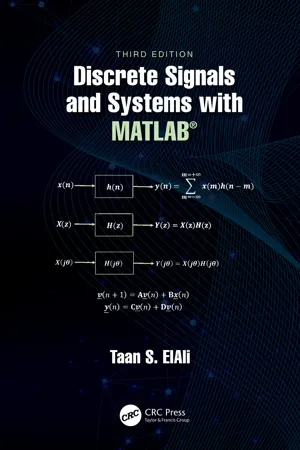
- 342 pages
- English
- ePUB (mobile friendly)
- Available on iOS & Android
Discrete Signals and Systems with MATLAB®
About this book
The subject of Discrete Signals and Systems is broad and deserves a single book devoted to it. The objective of this textbook is to present all the required material that an undergraduate student will need to master this subject matter and the use of MATLAB.
This book is primarily intended for electrical and computer engineering students, and especially for use by juniors or seniors in these undergraduate engineering disciplines. It can also be very useful to practicing engineers. It is detailed, broad, based on mathematical basic principles, focused, and it also contains many solved problems using analytical tools as well as MATLAB.
The book is ideal for a one-semester course in the area of discrete linear systems or digital signal processing, where the instructor can cover all chapters with ease. Numerous examples are presented within each chapter to illustrate each concept when and where it is presented. Most of the worked-out examples are first solved analytically and then solved using MATLAB in a clear and understandable fashion.
Frequently asked questions
- Essential is ideal for learners and professionals who enjoy exploring a wide range of subjects. Access the Essential Library with 800,000+ trusted titles and best-sellers across business, personal growth, and the humanities. Includes unlimited reading time and Standard Read Aloud voice.
- Complete: Perfect for advanced learners and researchers needing full, unrestricted access. Unlock 1.4M+ books across hundreds of subjects, including academic and specialized titles. The Complete Plan also includes advanced features like Premium Read Aloud and Research Assistant.
Please note we cannot support devices running on iOS 13 and Android 7 or earlier. Learn more about using the app.
Information
1Signal Representation
1.1Introduction
Table of contents
- Cover
- Half Title
- Series
- Title
- Copyright
- Dedication
- Contents
- Preface
- About the Author
- Acknowledgment
- Chapter 1 Signal Representation
- Chapter 2 Discrete System
- Chapter 3 Fourier Series and the Fourier Transform of Discrete Signals
- Chapter 4 z-Transform and Discrete Systems
- Chapter 5 Discrete Fourier Transform and Discrete Systems
- Chapter 6 State-Space and Discrete Systems
- Index